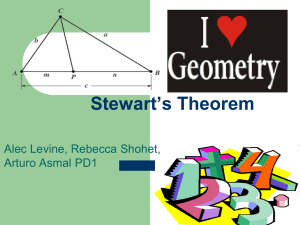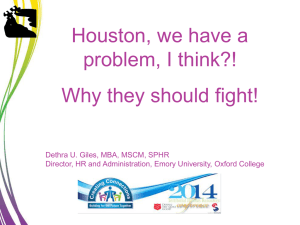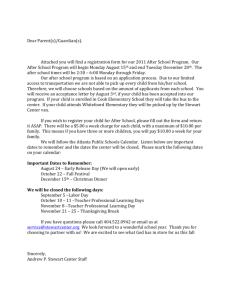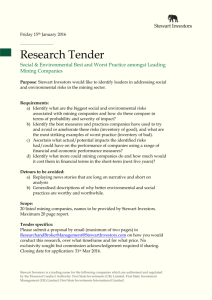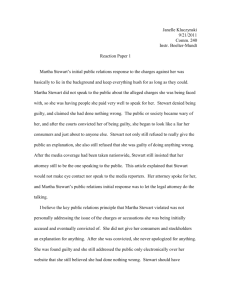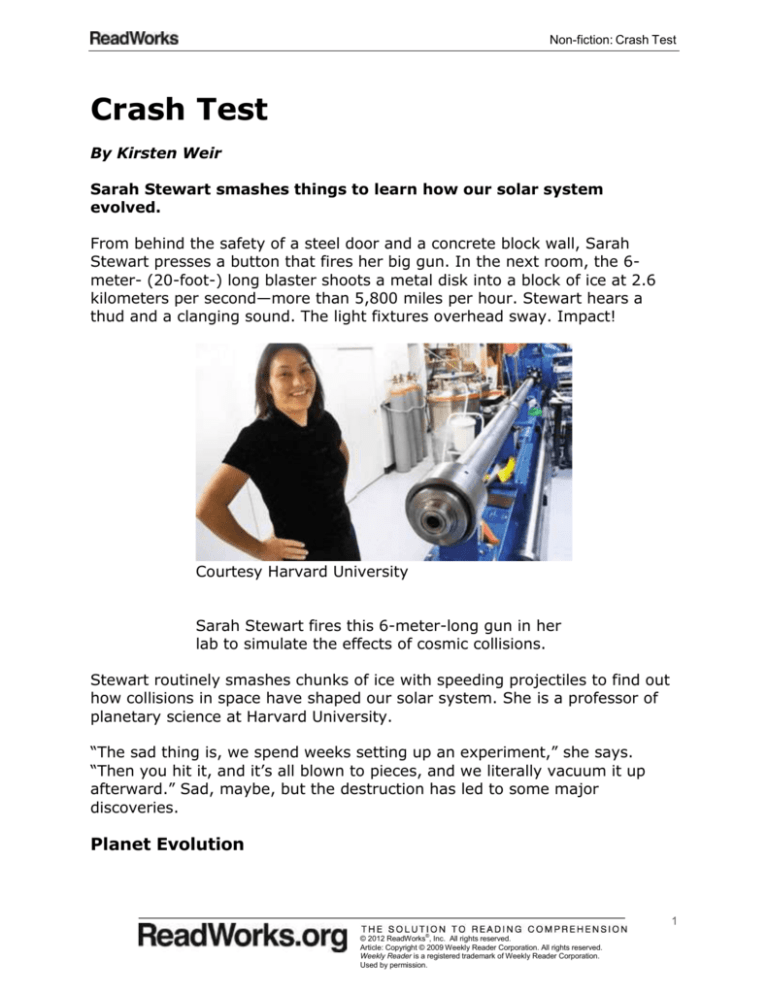
Non-fiction: Crash Test
Crash Test
By Kirsten Weir
Sarah Stewart smashes things to learn how our solar system
evolved.
From behind the safety of a steel door and a concrete block wall, Sarah
Stewart presses a button that fires her big gun. In the next room, the 6meter- (20-foot-) long blaster shoots a metal disk into a block of ice at 2.6
kilometers per second—more than 5,800 miles per hour. Stewart hears a
thud and a clanging sound. The light fixtures overhead sway. Impact!
Courtesy Harvard University
Sarah Stewart fires this 6-meter-long gun in her
lab to simulate the effects of cosmic collisions.
Stewart routinely smashes chunks of ice with speeding projectiles to find out
how collisions in space have shaped our solar system. She is a professor of
planetary science at Harvard University.
“The sad thing is, we spend weeks setting up an experiment,” she says.
“Then you hit it, and it’s all blown to pieces, and we literally vacuum it up
afterward.” Sad, maybe, but the destruction has led to some major
discoveries.
Planet Evolution
1
© 2012 ReadWorks®, Inc. All rights reserved.
Article: Copyright © 2009 Weekly Reader Corporation. All rights reserved.
Weekly Reader is a registered trademark of Weekly Reader Corporation.
Used by permission.
Non-fiction: Crash Test
Stewart was born in Taiwan, the daughter of an American father and a
Taiwanese mother. Her dad was in the Air Force, so she moved around the
world as she grew up.
As a kid, Stewart loved getting lost in the pages of science-fiction novels. In
college, she got hooked on astronomy and signed up to work in a lab,
studying how planets form. That led to a graduate degree at the California
Institute of Technology, where she began researching collisions in space.
“Coming out of high school, I would never have predicted that I’d work on
planets colliding with one another,” she says.
Planets are created when smaller rocks crash into one another and fuse,
Stewart explains. Even after a planet has formed, it keeps getting
pummeled. Most of the moons and rocky planets in the solar system are
pockmarked with craters from smashups with comets and asteroids.
“Collisions have occurred the whole time the solar system has been in
existence,” Stewart says.
The collisions leave lasting impressions. Nearly every rocky body in the solar
system has an odd feature that can be explained by a crash, says Stewart.
Impacts happen elsewhere in the universe too. Many exoplanets (planets
that exist outside our solar system) are surrounded by telltale dust clouds
that could have been caused only by collisions, she notes.
“If you want to understand the solar system, you want to understand impact
events and what they left behind,” Stewart says. “It’s like a detective story.”
Master Blaster
Stewart studies one particular material that’s prevalent in space: “I have this
special love of ice,” she admits. Most of the rocky bodies in our solar system
are at least partially covered in one form of ice or another.
Plain old water ice is composed of two atoms of hydrogen and one atom of
oxygen—H2O. Not all water ice is created equal, however. “You can arrange
the hydrogens and oxygens in different ways,” Stewart says. Scientists know
of at least 15 different crystal structures of frozen H2O, and more are being
discovered all the time.
Water ice also mixes with other compounds, such as ammonia or methane.
Those ices each have many different crystal structures too.
2
© 2012 ReadWorks®, Inc. All rights reserved.
Article: Copyright © 2009 Weekly Reader Corporation. All rights reserved.
Weekly Reader is a registered trademark of Weekly Reader Corporation.
Used by permission.
Non-fiction: Crash Test
The impact of a collision in space can transform the crystal structure of ice.
“When you take normal ice and hit it really fast with an asteroid or a comet,
you can make forms of ice that last just a few seconds,” says Stewart.
To understand those fleeting, frozen forms, Stewart gets out the big gun.
She fires metal disks into blocks of ice to mimic what happens when a space
rock hurtles into the icy shell of a moon or a rocky planet. For fractions of a
second, the block of ice experiences the extremely high pressures and
temperatures that occur during a cosmic collision.
During that split second, scientific instruments record temperature,
pressure, and other variables. After the blast, Stewart collects the smashed
sample to examine how it changed and pours over the data collected by the
instruments. Then she plugs every detail into a computer model to help her
understand how a similar impact might affect a real planet.
Mystery Solved
In 2010, Stewart’s big gun helped solve a mystery—the unusual craters
within craters in the ice on three of Jupiter’s moons (Europa, Callisto, and
Ganymede). Her experiments revealed how the odd craters formed. At the
moment of impact, Stewart discovered, ordinary ice on the surface was
transformed into two different phases of ice not normally seen on Earth.
Although the two forms lasted for only a moment, they left their mark in the
shape of a crater within a crater.
For Stewart, solving such mysteries is the best part of being a scientist. “You
have this tremendous feeling of excitement,” she says, “when you realize
something absolutely new that nobody else in the world knows.”
3
© 2012 ReadWorks®, Inc. All rights reserved.
Article: Copyright © 2009 Weekly Reader Corporation. All rights reserved.
Weekly Reader is a registered trademark of Weekly Reader Corporation.
Used by permission.
Non-fiction: Crash Test
Crash Victims
Cosmic collisions have molded some of our solar system’s rocky
bodies. Here’s how:
Mercury has an unexpectedly small mantle. The mantle is the layer of
a rocky planet that exists between the crust and the core. “One theory
is that a giant impact blew off most of the mantle,” says scientist
Sarah Stewart.
NASA
Venus has a retrograde rotation. It spins in the opposite direction as
most of the other planets rotate. (Earth turns counterclockwise; Venus
turns clockwise.) A huge collision might have sent it spinning
backward.
NASA
Earth’s moon formed, most scientists believe, after a Mars-sized object
called Theia smashed into the young Earth. The impact ejected chucks
of rock into space that gradually accreted (fused) to become the
moon.
4
© 2012 ReadWorks®, Inc. All rights reserved.
Article: Copyright © 2009 Weekly Reader Corporation. All rights reserved.
Weekly Reader is a registered trademark of Weekly Reader Corporation.
Used by permission.
Non-fiction: Crash Test
NASA
Mars has a crust that is twice as thick at the south pole as it is at the
north pole. The crust is the solid outermost layer of a rocky planet or
moon. A collision may have ripped off part of the planet’s northern
crust.
NASA
5
© 2012 ReadWorks®, Inc. All rights reserved.
Article: Copyright © 2009 Weekly Reader Corporation. All rights reserved.
Weekly Reader is a registered trademark of Weekly Reader Corporation.
Used by permission.
Questions: Crash Test
Name:
Date:
1. What did Sarah Stewart enjoy reading as a kid?
A fairy tales and fables
B science fiction novels
C autobiographies
D detective stories
2. This passage includes a list, giving examples of something. What do all of the
examples have in common?
A They are space objects that were visited by astronauts.
B They are space objects possibly changed by collisions.
C They are different planets in our solar system.
D They are about the same size and distance from Earth.
3. Which of the following conclusions about cosmic collisions is supported by the
passage?
A Fewer cosmic collisions will occur in the future.
B Cosmic collisions are a rare occurrence.
C The effects of cosmic collisions are minor.
D Collisions in space will continue to occur.
4. Read this sentence from the passage: “Stewart studies one particular material that’s
prevalent in space: ‘I have this special love of ice,’ she admits.”
In this sentence, the word prevalent means
A very rare
B sought after
C endangered
D common
5. Which statement supports the main idea of the passage?
A Planets are created when smaller rocks collide into one another and fuse.
B The planetary science department at Harvard University is respected.
C Sarah Stewart smashes ice to learn more about our solar system.
D Many solar system bodies have craters caused by cosmic impacts.
1
®
© 2012 ReadWorks , Inc. All rights reserved.
Questions: Crash Test
6. Where was Stewart born?
7. How, do you think, does Stewart feel about her job as a professor of planetary
science? How do you know? Give specific examples from the text to support your
answer.
8. The question below is an incomplete sentence. Choose the word that best completes
the sentence.
Sarah Stewart fires metal disks
have shaped our solar system.
A
B
C
D
chunks of ice to learn how collisions in space
from
into
for
and
2
®
© 2012 ReadWorks , Inc. All rights reserved.
Questions: Crash Test
9. Answer the following questions based on the sentence below.
In 2010, Sarah Stewart conducted experiments to explain how the unusual craters
within craters in the ice on three of Jupiter’s moons formed.
Who?
(did) What?
Why? to explain how the unusual craters within craters in the ice on three of Jupiter’s
moons formed
When?
10. Vocabulary Word: cosmic: relating to the universe.
Use the vocabulary word in a sentence:
3
®
© 2012 ReadWorks , Inc. All rights reserved.
Teacher Guide & Answers: Crash Test
4
© 2012 ReadWorks®, Inc. All rights reserved.


